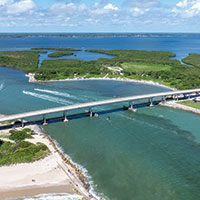 Inlet bridge debris will be reclaimed for artificial reef
Inlet bridge debris will be reclaimed for artificial reef
STORY BY JON PINE (Week of September 11, 2025)
After the new bridge over the Sebastian Inlet is built, you will still be able to visit the old bridge – portions of it, anyway – but you’ll need diving gear for the experience.
Working with the Coastal Conservation Association and Florida Department of Transportation, Indian River County has come up with a plan to use 3,500 tons of debris from demolition of the old bridge to expand artificial reefs outside the inlet.
FDOT is set to begin construction on the new $111.7- million Sebastian Inlet Bridge early next year and complete it by 2031. Demolition of the old bridge, which was built in the 1960s, is expected to begin in 2028, according to the CCA’s Logan Kennovin.
Once the big chunks of concrete and steel are in place, it will take about a year for sessile organisms – algae, barnacles, corals and sponges – to grow on the concrete. After another year, the reef will begin to attract fish that live in open water, such as mackerel, sailfish and other gamefish – along with baitfish, Kennovin said.
Florida is a leader in the artificial reef movement, with approximately 4,500 reefs scattered along the state’s 1,350-mile coast, including several dozen along the Indian River County shoreline. Manmade reefs can be purpose-built structures, sunken ships, railroad cars or old tires as well as construction rubble.
The idea of reclaiming part of the old bridge for deployment as an artificial reef took shape when Kennovin, CCA’s assistant director of habitat and environmental restoration, heard about the upcoming replacement and contacted FDOT.
“They were all ears,” said Kennovin, who then met with the county’s Natural Resources Department, where staff members were equally enthusiastic.
The county and CCA calculated it would cost $220,000 for FDOT to barge 3,500 tons of bridge debris – about half the total amount – out to the county’s Orchid Island Artificial Reef complex, a group of eight artificial reefs located 10-11 miles offshore in 65 to 70 feet of water about three miles south of the inlet.
The county has permits from the U.S. Army Corps of Engineers for up to 12 artificial reefs at that site, and the upcoming project will add rubble to five of those reefs, said Kylie Yanchula, director of the county’s Natural Resources Department.
“We committed to $110,000 and the county agreed to come up with the other half,” said Kennovin. In exchange, the county agreed to let CCA name the reefs.
Founded by 14 fishermen in a tackle shop in 1977, CCA’s mission includes protecting and increasing fish stocks in coastal waters, and reefs – both natural and artificial – to benefit fish populations, along with other marine animals. They are also credited with increasing biodiversity, protecting shorelines and boosting coastal economies.
The County Commission approved the plan in August.
“This collaborative project is a testament to what we can achieve through strong partnerships to deliver service excellence,” said County Administrator John Titkanich. “By working alongside FDOT, CCA, and our state representative, Robbie Brackett, Indian River County is able to deliver meaningful projects that serve our community and strengthen our coastal resources.”
“We’ve seen firsthand how important it is to provide solid substrate in our coastal waters,” said Edie Widder, founder and senior scientist at the Ocean Research & Conservation Association in Vero Beach. “Structures like artificial reefs create critical surfaces for oysters, barnacles, and other marine life to attach to, while also offering shelter for fish and countless smaller creatures. By enhancing habitat in this way, artificial reefs help support healthier, more resilient ocean ecosystems.”
In addition to repopulating aquatic species, artificial reefs are a boon to local economies, drawing sport fishermen and leisure divers who stay in local hotels and buy gas, food and other supplies.
“The deployment of this artificial reef is an investment in the health of our coastal ecosystem and our community,” said Yanchula. “It will create new marine habitat, support local fisheries, and enhance recreational opportunities for our residents and visitors.”



